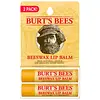What's inside
What's inside
 Key Ingredients
Key Ingredients

 Benefits
Benefits

 Concerns
Concerns

 Ingredients Side-by-side
Ingredients Side-by-side

Hydrogenated Coconut Oil
EmollientCera Alba
EmollientEthylhexyl Methoxycinnamate
UV AbsorberSimmondsia Chinensis Seed Oil
EmollientHelianthus Annuus Seed Oil
EmollientCanola Oil
EmollientJojoba Esters
EmollientTocopheryl Acetate
AntioxidantDimethicone
EmollientChamomilla Recutita Flower Extract
MaskingPhenoxyethanol
PreservativeIsopropyl Myristate
EmollientVanillin
MaskingAloe Barbadensis Leaf Juice
Skin ConditioningSaccharin
MaskingAlumina
AbrasivePolyhydroxystearic Acid
EmulsifyingSilica
AbrasiveBHT
AntioxidantCI 77891
Cosmetic ColorantHydrogenated Coconut Oil, Cera Alba, Ethylhexyl Methoxycinnamate, Simmondsia Chinensis Seed Oil, Helianthus Annuus Seed Oil, Canola Oil, Jojoba Esters, Tocopheryl Acetate, Dimethicone, Chamomilla Recutita Flower Extract, Phenoxyethanol, Isopropyl Myristate, Vanillin, Aloe Barbadensis Leaf Juice, Saccharin, Alumina, Polyhydroxystearic Acid, Silica, BHT, CI 77891
 Reviews
Reviews

Ingredients Explained
These ingredients are found in both products.
Ingredients higher up in an ingredient list are typically present in a larger amount.
Canola Oil is Rapeseed oil with low amounts of erucic acid. It is an emollient and helps hydrate the skin. Emollients help hydrate and soften your skin by trapping moisture.
The comedogenic rating of canola oil is 4.
Canola oil contains Vitamin E, Vitamin K, and fatty acids such as linoleic acid.
Learn more about Canola OilCera alba is beeswax, or the wax used by bees to make honeycombs. It is a texture-enhancer and emollient. A study from 2003 found beeswax to be a stronger emollient than ingredients such as petroleum jelly.
As an emollient, beeswax helps hydrate the skin by creating a barrier on top. This barrier traps moisture in.
Emulsifiers help prevent ingredients from separating. This helps create consistent texture.
The structure of beeswax is mainly long-chain alcohols and the esters of fatty acids.
There are three types of beeswax: yellow, white, and absolute. Yellow is pure beeswax taken from the honeycomb. White beeswax is created by filtering or bleaching yellow beeswax. Absolute beeswax is created by treating beeswax with alcohol. Beeswax used in cosmetics are purified.
Beeswax has been used throughout history and even in prehistoric times. Some common uses for beeswax still used today are making candles, as a waterproofing agent, and polish for leather.
Learn more about Cera AlbaHelianthus Annuus Seed Oil is the oil derived from the seeds of a Sunflower. Sunflower seed oil is non-fragrant. It is an emollient, meaning it helps to soften the skin.
Sunflower seed oil contains many fatty acids. The fatty acids found in sunflower seeds include (from highest amount to least): linoleic acid, myristic acid, palmitic acid, stearic acid, arachidic acid, oleic acid, and linolenic acid.
These fatty acids help the skin create ceramides. Ceramides play a role in repairing the skin barrier.
Helianthus Annuus Seed Oil helps moisturize the skin. This in turn helps the skin look more rejuvenated and smoother.
Sunflowers are rich in vitamin E.
Historians believe Indigenous cultures of North America domesticated sunflowers before corn. Thus they relied on sunflower oil for a variety of uses. One such use is moisturizing skin and hair.
Sunflower seed oil may not be fungal acne safe. We recommend speaking with a professional if you have any concerns.
Learn more about Helianthus Annuus Seed Oil